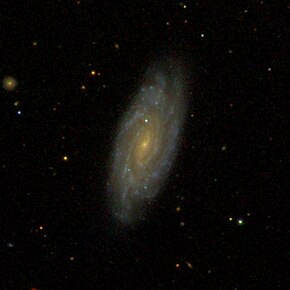NGC 4712
 From Wikipedia the free encyclopedia
From Wikipedia the free encyclopedia
| NGC 4712 | |
|---|---|
 NGC 4712 as seen during the Sloan Digital Sky Survey (SDSS) | |
| Observation data (J2000 epoch) | |
| Constellation | Coma Berenices |
| Right ascension | 12h 49m 33s |
| Declination | +25° 28’ 11” |
| Distance | ∼224 million ly |
| Apparent magnitude (B) | 13.5 |
| Surface brightness | 22.66 mag/arcsec^2 |
| Characteristics | |
| Type | SAbc |
| Other designations | |
| PGC 43368, UGC 7977, MCG 4-30-21, CGCG 129-25, KUG 1247+257A, IRAS 12471+2544 | |
NGC 4712 is a spiral galaxy located in the constellation Coma Berenices. Its speed relative to the cosmic microwave background is 4,664 ± 20 km/s, which corresponds to a Hubble distance of 68.8 ± 4.8 Mpc (∼224 million ly).[1] NGC 4712 was discovered by German-British astronomer John Herschel in 1832.
The luminosity class of NGC 4712 is II-III and it has a broad HI line. It also contains regions of ionized hydrogen.[1]
To date, around ten measurements not based on redshift give a distance of 63.640 ± 16.932 Mpc (∼208 million ly),[2] which is within the distance values of Hubble. Note, however, that it is with the average value of independent measurements, when they exist, that the NASA/IPAC database calculates the diameter of a galaxy and that consequently the diameter of NGC 4712 could be approximately 51 .4 kpc (∼168,000 ly)[2] if we used the Hubble distance to calculate it.[3]
According to Vaucouleur and Harold Corwin, NGC 4712 and NGC 4725 form a pair of galaxies. However, like several others mentioned in this article, these two galaxies are not an actual pair, because NGC 4725's radial velocity is 1,209 ± 1 km/s and is therefore much closer to the Milky Way. It is therefore an optical pair.[4]
See also[edit]
External links[edit]
References[edit]
- ^ a b "By Name | NASA/IPAC Extragalactic Database". ned.ipac.caltech.edu. Retrieved 2024-06-06.
- ^ a b "NED Query Results for NGC 4712". ned.ipac.caltech.edu. Retrieved 2024-06-06.
- ^ "NGC 4712". spider.seds.org. Retrieved 2024-06-06.
- ^ "NGC_4712". simbad.u-strasbg.fr. Retrieved 2024-06-06.